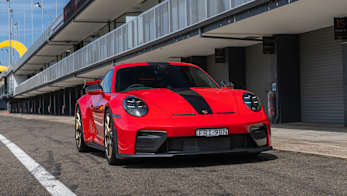In the 1980s carmakers reckoned badge engineering was the key to success, and in some case survival. Model sharing was rife, with Toyotas badged as Holdens, Hondas as Rovers, and Mazdas as Fords.
Ford and Mazda formed an alliance, with Ford acquiring a financial stake in the Japanese company, and many of Mazda’s models were ‘badge engineered’ and appeared in Ford showrooms.
Among them was the Telstar, Ford’s remake of the Mazda 626, which was on sale at the same time in Mazda showrooms.
MODEL WATCH
Mazda introduced the new front-wheel drive 626 in 1983 to some high praise, winning many friends and a number of awards.
While the Mazda was imported Ford built a slightly different version locally, and it too won its share of friends among local car buyers.
It was a good looking car, nicely equipped, and came in four-door sedan and five-door hatch versions in both ranges, with the Mazda also offered as a coupe.
Power was from a single overhead camshaft four-cylinder engine, which had a carburettor and put out 70 kW and 158 Nm. Buyers could choose between a five-speed manual gearbox or three-speed auto.
The base 626 had manual steering and there were a few complaints about the steering effort needed, particularly when parking. Other models, however, had power steering, as well as air-con, cruise, power windows and mirrors, and central locking.
It was much the same story over at Ford dealers where you had to put up with manual steering on the base model GL, when the Ghia not only got power steering, but also power mirrors and windows, and radio-cassette sound.
A 1985 update brought better ride and handling, improved brakes, and a new dash, with power steering an option on the base models. Another update in 1986 brought with it engines able to run on unleaded fuel.
IN THE SHOP
As with any car of the age of the Telstar/Mazda 626 it’s vitally important to approach them with care and your eyes wide open.
If they’ve been in regular use since the mid-1980s they will have accumulated well in excess of 200,000 km, some will have done more than 300,000 km, and that generally means trouble is never far away.
The best policy is to search for a well kept car with low mileage. One that has a service record that tells you it has been regularly serviced.
Walk away from any car that looks as though it has been parked under a tree all its life, has bumps and scrapes on all panels, the seats are ripped and torn, and its oil is black and thick.
Look for oil leaks around the engine, particularly from the rocker cover, and perished radiator hoses which can lead to problems if they fail on the job.
Make sure all accessories work, power windows and the like can be expensive to fix if they’re not operating.
Checking for evidence of a crash is even more important with older cars as the likelihood they have been in a crash is high.
Have someone drive the car down the road, back and forth and carefully watch to see it tracks straight and true.
Carefully inspect all panels for imperfections, colour mismatches, and varying gaps. Open and close all doors, hatches and bonnet and observe for smooth operation.
Finally look for rust, particularly around the rear and side windows.
IN A CRASH
Well before the advent of airbags occupants in the Telstar/626 have to rely on much more rudimentary protection systems in a crash.
Of primary importance are the seat belts, and these should be checked for function and any sign that the belt webbing has deteriorated. It’s really a good idea to replace the belts to be sure you’ve got the best protection possible in a crash.
The Telstar/626 was rated on average with the fleet norm in terms of protecting its occupants, but better than the average when it came to protecting the occupants of the other car involved in the crash.
OWNERS SAY
Neville Kretschme has owned his 1985 2.0-litre manual Telstar GL since 1987 when he bought it with 75,000 km on the clock. It has now done 158,660 km, low for its age, and remains in excellent condition. Overall it has been reliable, Neville having replaced a head gasket, alternator, exhaust system, brakes, rear shock absorbers and a radiator.
Lyndall McLean drives the Telstar auto sedan his mother bought new in 1986. It now has 170,000 km on the odo and has been reliable and cheap to run, his only complaint being the heavy non-power steering. Apart from normal services Lyndall has replaced one drive shaft boot, an ignition module, exhaust system, a couple of oil seals and a water pump.
Anthony Jones owns a 1985 Mazda 626 Super Deluxe hatch that’s done 210,000 km and it still runs like clockwork. It gets around 9.0 L/100 km on unleaded fuel, is reliable and handles well although he says the suspension is a bit hard and choppy.
LOOK FOR
• Economical to run
• Overall quite reliable
• Rust around rear and side windows
• Comfortable ride
• Reassuring ride and handling
• Low odo reading
• Verifiable service record
• Evidence of crash repairs
VERDICT
Cheap reliable transport for young drivers if you can find a low mileage well cared for example.
RATING
60/100
Mazda 626 1983: Se
| Engine Type | Inline 4, 2.0L |
|---|---|
| Fuel Type | Leaded Petrol |
| Fuel Efficiency | 10.5L/100km (combined) |
| Seating | 5 |












.jpg)

.jpg)

.jpg)
.jpg)
